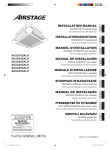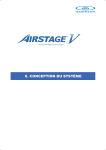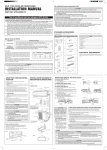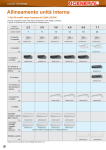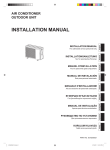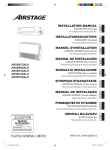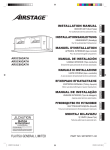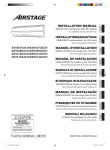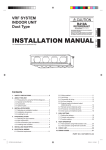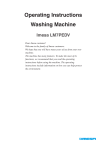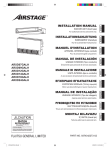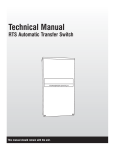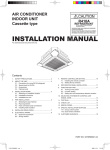Download INSTALLATION MANUAL
Transcript
INSTALLATION MANUAL English VRF SYSTEM INDOOR UNIT Cassette Type For authorized service personnel only. Contents 1. SAFETY PRECAUTIONS ............................................. 2 2. ABOUT THE UNIT 2.1. Precautions for using the R410A refrigerant .......... 2 2.2. Special tool for R410A............................................ 2 2.3. Accessories ............................................................ 2 2.4. Optional parts ......................................................... 3 3. INSTALLATION WORK 3.1. Selecting an installation location ............................ 3 3.2. Installation dimensions ........................................... 4 3.3. Installing the unit .................................................... 5 4. PIPE INSTALLATION 4.1. Selecting the pipe material ..................................... 7 4.2. Pipe requirement .................................................... 7 4.3. Flare connection (pipe connection) ........................ 7 4.4. Installing heat insulation ......................................... 8 5. INSTALLING DRAIN PIPES.......................................... 9 6. ELECTRICAL WIRING 6.1. Electrical requirement .......................................... 11 6.2. Wiring method ...................................................... 11 6.3. Unit wiring ............................................................ 11 6.4. Connection of wiring............................................. 13 6.5. External input and external output (Optional parts) .................................................. 14 7. FIELD SETTING 7.1. Setting the address .............................................. 16 7.2. Custom code setting ............................................ 17 7.3. Function setting .................................................... 18 8. DECORATION PANEL INSTALLATION ...................... 19 9. TEST OPERATION 9.1. Test operation using PCB (Outdoor unit) ............. 19 9.2. Test operation using Remote Controller ............... 19 10. CHECK LIST ............................................................... 19 11. ERROR CODES ......................................................... 20 PART NO. 9371022208-02 9371022208-02_IM_EN.indd 1 8/31/2012 2:41:51 PM 1. SAFETY PRECAUTIONS 2.2. Special tool for R410A • Be sure to read this Manual thoroughly before installation. • The warnings and precautions indicated in this Manual contain important information pertaining to your safety. Be sure to observe them. • Hand this Manual, together with the Operating Manual to the customer. Request the customer to keep them on hand for future use, such as for relocating or repairing the unit. This mark indicates procedures which, if WARNING • To install a unit that uses the R410A refrigerant, use dedicated tools and piping materials that have been manufactured specifically for R410A use. Because the pressure of the R410A refrigerant is approximately 1.6 times higher than the R22, failure to use dedicated piping material or improper installation can cause rupture or injury. Furthermore, it can cause serious accidents such as water leakage, electric shock, or fire. WARNING! improperly performed, might lead to the death or serious injury of the user. • Request your dealer or a professional installer to install the unit in accordance with this Manual. An improperly installed unit can cause serious accidents such as water leakage, electric shock, or fire. If the unit is installed in disregard of the instructions in the Installation Manual, it will void the manufacturer’s warranty. • Do not turn ON the power until all work has been completed. Turning ON the power before the work is completed can cause serious accidents such as electric shock or fire. • If refrigerant leaks while work is being carried out, ventilate the area. If the refrigerant comes in contact with a flame, it produces a toxic gas. • Installation work must be performed in accordance with national wiring standards by authorized personnel only. • Except for EMERGENCY, never turn off main as well as sub breaker of the indoor units during operation. It will cause compressor failure as well as water leakage. First, stop the indoor unit by operating the control unit, converter or external input device and then cut the breaker. Make sure to operate through the control unit, converter or external input device. When the breaker is designed, locate it at a place where the users cannot start and stop in the daily work. CAUTION! This mark indicates procedures which, if improperly performed, might possibly result in personal harm to the user, or damage to property. 2. ABOUT THE UNIT 2.1. Precautions for using the R410A refrigerant WARNING • Do not introduce any substance other than the prescribed refrigerant into the refrigeration cycle. If air enters the refrigeration cycle, the pressure in the refrigeration cycle will become abnormally high and cause the piping to rupture. • If there is a refrigerant leakage, make sure that it does not exceed the concentration limit. If a refrigerant leakage exceeds the concentration limit, it can lead to accidents such as oxygen starvation. • Do not touch refrigerant that has leaked from the refrigerant pipe connections or other area. Touching the refrigerant directly can cause frostbite. • If a refrigerant leakage occurs during operation, immediately vacate the premises and thoroughly ventilate the area. If the refrigerant comes in contact with a flame, it produces a toxic gas. Tool name Contents of change Pressure is huge and cannot be measured with a conventional gauge. To prevent erroneous mixing of other refrigerants, the diameter of each port Gauge manifold has been changed. It is recommended to use a gauge manifold with a high pressure display range –0.1 to 5.3 MPa and a low pressure display range –0.1 to 3.8 MPa. Charging hose To increase pressure resistance, the hose material and base size were changed. Vacuum pump A conventional vacuum pump can be used by installing a vacuum pump adapter. Be sure that the pump oil does not backflow into the system. Use one capable for vacuum suction of –100.7 kPa (5 Torr, –755 mmHg). Gas leakage detector Special gas leakage detector for HFC refrigerant R410A. 2.3. Accessories WARNING • For installation purposes, be sure to use the parts supplied by the manufacturer or other prescribed parts. The use of non-prescribed parts can cause serious accidents such as the unit to fall, water leakage, electric shock, or fire. • The following installation parts are furnished. Use them as required. • Keep the Installation Manual in a safe place and do not discard any other accessories until the installation work has been completed. En-2 9371022208-02_IM_EN.indd 2 8/31/2012 2:42:05 PM Name and Shape Q’ty Application Operation Manual 2.4. Optional parts The following options are available. 1 Installation Manual • External output wire (P/N 9379529006) • External input (voltage) wire (P/N 9368779016) • External input (no voltage) wire (P/N 9368779009) (This book) 1 Cable tie (Large) 4 3. INSTALLATION WORK For fixing the connection pipe (Large and Small) Especially, the installation place is very important for the split type air conditioner because it is very difficult to move from place to place after the first installation. 3.1. Selecting an installation location Cable tie (Medium) 3 Coupler heat insulation (Small) Coupler heat insulation (Large) For transmission and remote controller cable binding. For indoor side pipe joint (Small) 1 For indoor side pipe joint (Large) 1 For installing indoor unit. Template (Carton top) 1 Washer For installing indoor unit. 8 For installing drain pipe Insulation 1 For installing drain pipe VP25 (O.D.32, I.D.25) For installing drain hose Hose Band Assy CAUTION • Do not install the unit in the following areas: • Area with high salt content, such as at the seaside. It will deteriorate metal parts, causing the parts to fall or the unit to leak water. • Area filled with mineral oil or containing a large amount of splashed oil or steam, such as a kitchen. It will deteriorate plastic parts, causing the parts to fall or the unit to leak water. • Area that generates substances that adversely affect the equipment, such as sulfuric gas, chlorine gas, acid, or alkali. It will cause the copper pipes and brazed joints to corrode, which can cause refrigerant leakage. • Area that can cause combustible gas to leak, contains suspended carbon fibers or flammable dust, or volatile inflammables such as paint thinner or gasoline. If gas leaks and settles around the unit, it can cause a fire. • Area where animals may urinate on the unit or ammonia may be generated. • Do not use the unit for special purposes, such as storing food, raising animals, growing plants, or preserving precision devices or art objects. It can degrade the quality of the preserved or stored objects. • Do not install where there is the danger of combustible gas leakage. 1 Drain Hose Assy WARNING • Select installation locations that can properly support the weight of the indoor. Install the units securely so that they do not topple or fall. 1 • Do not install the unit near a source of heat, steam, or flammable gas. • Install the unit where drainage does not cause any trouble. • Install the indoor unit, outdoor unit, power supply cable, transmission cable, and remote controller cable at least 1 m away from a television or radio receivers. The purpose of this is to prevent TV reception interference or radio noise. (Even if they are installed more than 1 m apart, you could still receive noise under some signal conditions.) • If children under 10 years old may approach the unit, take preventive measures so that they cannot reach the unit. Drain Pipe Insulation For installing drain pipe 1 En-3 9371022208-02_IM_EN.indd 3 8/31/2012 2:42:05 PM • Decide the mounting position with the customer as follows: • Discharge Direction Setting • The discharge direction can be selected as shown below. (1) Install the indoor unit on a place having a sufficient strength so that it withstands against the weight of the indoor unit. (2) The inlet and outlet ports should not be obstructed; the air should be able to blow all over the room. (3) Leave the space required to service the air conditioner. (4) A place from where the air can be distributed evenly throughout the room by the unit. (5) Install the unit where connection to the outdoor unit is easy. (6) Install the unit where the connection pipe can be easily installed. (7) Install the unit where the drain pipe can be easily installed. (8) Install the unit where noise and vibrations are not amplified. (9) Take servicing, etc., into consideration and leave the spaces. Also install the unit where the filter can be removed. 3.2. Installation dimensions • The ceiling rear height as shown in the figure. Strong and durable ceiling 3,000 mm or more 256 mm or more (AUXD18,24) 298 mm or more (AUXA30,36,45,54) H 1,800 mm or more 1,000 mm or more 4 DIRECTION 1,500 mm or more Obstruction Floor H (The maximum height from floor to ceiling)(mm) Model name AUXD18 AUXD24 AUXA30 AUXA36 AUXA45 AUXA54 Standard mode 3,000 3,000 3,200 3,200 3,200 3,200 High Ceiling mode 3,500 3,500 3,600 4,200 4,200 4,200 100 mm or more 3 DIRECTION * Select the most appropriate airflow direction from 3 or 4 directions according to the shape of the room and the installation position. * When changing the number of outlets, we recommend using the optional AIR OUTLET SHUTTER PLATE KIT to close the outlet. * For the specific closing pattern, please refer to the attached AIR OUTLET SHUTTER PLATE KIT’S MANUAL. (Do so before installing the decorative panel as it will be installed on the body.) * Be sure to make the function settings with the remote controller according to the number of airflow outlets and the installed ceiling height. En-4 9371022208-02_IM_EN.indd 4 8/31/2012 2:42:09 PM • Refrigerant piping and drain piping positions. 3.3. Installing the unit 10 mm • If the job is done with the panel frame only, there is a risk that the unit will come loose. Please take care. 3.3.1. Position the ceiling hole and hanging bolts 950 mm (Panel frame) 20 - 45 mm 20 - 45 mm 200 mm • Distribution ducts and fresh air inlet positions. Distribution duct connecting port Fresh air inlet position Distribution duct connecting port 50 mm 130 mm 278 mm Distribution duct connecting port 20 - 45 mm 130 mm 840 mm (Body frame) 80 mm 130 mm 699 mm (Hanging bolt pitch) 795 mm (Hanging bolt pitch) 950 mm (Panel frame) 860 - 910 mm (Ceiling opening) 840 mm (Body frame) 860 - 910 mm (Ceiling opening) 20 - 45 mm 358 mm 200 mm • Ceiling opening and hanging bolt pitch. Drain pipe (Connect the attached drain hose) 140 mm (1) Positions of the ceiling opening, hanging bolt pitch, piping and ducts. (unit: mm) Drain pipe Refrigerant pipe Distribution duct connecting port A B 185mm 352mm Ø 70mm Cut out 185mm 250mm 40 mm 10 mm B 256 298 10 x Ø 2.5 hole Detailed diagram of distribution duct connecting port (4 sides) Ø 88mm Burling hole pitch A 246 288 100mm 83mm Cut out 90mm 140 - 145 mm 50 - 100 mm 100mm 83mm Model 18/24L 30/36/45/54L 60 mm Gas pipe Liquid pipe 180 mm • Install the air conditioner in a location which can withstand a load do at least 5 times the weight of the main unit and which will not amplify sound or vibration. If the installation location is not strong enough, the indoor unit may fall and cause injuries. 80 mm WARNING 4 x Ø 2.5 hole Fresh air inlet position En-5 9371022208-02_IM_EN.indd 5 8/31/2012 2:42:10 PM Note: Conduct proper insulation when connecting the distribution ducts and fresh air inlet. Insulation 3.3.3. Body installation (1) Install the attached washer and nut (prepared on site) onto the hanging bolt. (2) Hook the body onto the hanging bolt. (3) Adjust the dimensions of the ceiling surface from the body. After installing the decorative panel, you can make fine adjustment of the height of the body. For details, refer to the installation manual of the decorative panel. WARNING • Perform final tightening by tightening the double nut firmly. • Be sure to install the body horizontally and adjust the height below the body and the ceiling surface properly. Hanging bolt Fresh air inlet position Nut A * When sucking in the fresh air, please detach the insulation affixed to the drain pan. (2) Setting the positions of hanging bolt and ceiling opening. • Use an installation template (packaging top surface) to set the positions of the hanging bolt and ceiling opening and drill holes. 30 or more Washer (3) Hanging structure. • Select a strong structure for the hanging location. • If necessary, reinforce the hanging bolt with quakeproof columnar support material to prevent shaking. • Use hanging bolts of M8-M10. After installing the body, tighten the nuts. 3.3.2. Hanging preparations Washer • Install the hanging bolts at a place where they would be capable of holding a weight of at least 490 N per bolt. Hole-in anchor Hole-in plug Concrete Nut B (Double Nut) 10~15 • Firmly fasten the hanging bolts as shown in the figure or by another method. Insert 3.3.4. Leveling • Using a level, or vinyl hose filled with water, fine adjust so that the body is level. • Inclined installation so as the drain pipe side is higher may cause a malfunction of the float switch, and may cause water leakage. Hanging bolt M10 Drain pipe Vinyl hoses En-6 9371022208-02_IM_EN.indd 6 8/31/2012 2:42:11 PM 4.2. Pipe requirement 4. PIPE INSTALLATION CAUTION CAUTION • Be more careful that foreign matter (oil, water, etc.) does not enter the piping than with refrigerant R410A models. Also, when storing the piping, securely seal the openings by pinching, taping, etc. • Refer to the Installation Manual of the outdoor unit for description of the length of connecting pipe or for difference of its elevation. • Use pipe with water-resistant heat insulation. • While welding the pipes, be sure to blow dry nitrogen gas through them. 4.1. Selecting the pipe material CAUTION • Do not use existing pipes. • Use pipes that have clean external and internal sides without any contamination which may cause trouble during use, such as sulfur, oxide, dust, cutting waste, oil, or water. • It is necessary to use seamless copper pipes. Material : Phosphor deoxidized seamless copper pipes It is desirable that the amount of residual oil is less than 40 mg/10 m. • Do not use copper pipes that have a collapsed, deformed, or discolored portion (especially on the interior surface). Otherwise, the expansion valve or capillary tube may become blocked with contaminants. • Improper pipe selection will degrade performance. As an air conditioner using R410A incurs pressure higher than when using conventional refrigerant, it is necessary to choose adequate materials. • Thicknesses of copper pipes used with R410A are as shown in the table. • Never use copper pipes thinner than those indicated in the table even if they are available on the market. Thicknesses of Annealed Copper Pipes (R410A) Pipe outside diameter [mm (in.)] Thickness [mm] 6.35 (1/4) 0.80 9.52 (3/8) 0.80 12.70 (1/2) 0.80 15.88 (5/8) 1.00 19.05 (3/4) 1.20 CAUTION • Install heat insulation around both the gas and liquid pipes. Failure to do so may cause water leaks. Use heat insulation with heat resistance above 120 °C. (Reverse cycle model only) In addition, if the humidity level at the installation location of the refrigerant piping is expected to exceed 70 %, install heat insulation around the refrigerant piping. If the expected humidity level is 70-80 %, use heat insulation that is 15 mm or thicker and if the expected humidity exceeds 80 %, use heat insulation that is 20 mm or thicker. If heat insulation is used that is not as thick as specified, condensation may form on the surface of the insulation. In addition, use heat insulation with heat conductivity of 0.045 W/(m·K) or less (at 20 °C). 4.3. Flare connection (pipe connection) WARNING • Tighten the flare nuts with a torque wrench using the specified tightening method. Otherwise, the flare nuts could break after a prolonged period, causing refrigerant to leak and generate a hazardous gas if the refrigerant comes into contact with a flame. 4.3.1. Flaring • Use special pipe cutter and flare tool exclusive for R410A. (1) Cut the connection pipe to the necessary length with a pipe cutter. (2) Hold the pipe downward so that cuttings will not enter the pipe and remove any burrs. (3) Insert the flare nut (always use the flare nut attached to the indoor and outdoor units respectively) onto the pipe and perform the flare processing with a flare tool. Use the special R410A flare tool, or the conventional flare tool. Leakage of refrigerant may result if other flare nuts are used. (4) Protect the pipes by pinching them or with tape to prevent dust, dirt, or water from entering the pipes. B Check if [L] is flared uniformly and is not cracked or scratched. Die A Pipe L En-7 9371022208-02_IM_EN.indd 7 8/31/2012 2:42:11 PM Pipe outside diameter [mm (in.)] Dimension A [mm] Flare tool for R410A, clutch type 0 Dimension B-0.4 [mm] 6.35 (1/4) 9.1 9.52 (3/8) 13.2 12.70 (1/2) 16.6 0 to 0.5 15.88 (5/8) 19.7 19.05 (3/4) 24.0 When using conventional flare tools to flare R410A pipes, the dimension A should be approximately 0.5 mm more than indicated in the table (for flaring with R410A flare tools) to achieve the specified flaring. Use a thickness gauge to measure the dimension A. Width across flats Pipe outside diameter [mm (in.)] Width across flats of Flare nut [mm] 6.35 (1/4) 17 9.52 (3/8) 22 12.70 (1/2) 26 15.88 (5/8) 29 19.05 (3/4) 36 4.3.2. Bending pipes • If pipes are shaped by hand, be careful not to collapse them. • Do not bend the pipes in an angle more than 90°. • When pipes are repeatedly bend or stretched, the material will harden, making it difficult to bend or stretch them any more. • Do not bend or stretch the pipes more than 3 times. (3) When the flare nut is tightened properly by your hand, hold the body side coupling with a separate spanner, then tighten with a torque wrench. (See the table below for the flare nut tightening torques.) CAUTION • Hold the torque wrench at its grip, keeping it in the right angle with the pipe, in order to tighten the flare nut correctly. • Tighten the flare nuts with a torque wrench using the specified tightening method. Otherwise, the flare nuts could break after a prolonged period, causing refrigerant to leak and generate a hazardous gas if the refrigerant comes into contact with a flame. Tighten with 2 wrenches. Holding wrench Flare nut Torque wrench Indoor unit pipe (Body side) Connection pipe Flare nut [mm (in.)] Tightening torque [N·m (kgf·cm)] 6.35 (1/4) dia. 16 to 18 (160 to 180) 9.52 (3/8) dia. 32 to 42 (320 to 420) 12.70 (1/2) dia. 49 to 61 (490 to 610) 15.88 (5/8) dia. 63 to 75 (630 to 750) 19.05 (3/4) dia. 90 to 110 (900 to 1,100) CAUTION • To prevent breaking of the pipe, avoid sharp bends. 4.4. Installing heat insulation • If the pipe is bent repeatedly at the same place, it will break. CAUTION • After checking for gas leaks (refer to the Installation Manual of the outdoor unit), perform this section. 4.3.3. Pipe connection CAUTION • Be sure to apply the pipe against the port on the indoor unit and the outdoor unit correctly. If the centering is improper, the flare nut cannot be tightened smoothly. If the flare nut is forced to turn, the threads will be damaged. • Do not remove the flare nut from the indoor unit pipe until immediately before connecting the connection pipe. • Do not use mineral oil on flared part. Prevent mineral oil from getting into the system as this would reduce the lifetime of the units. • Install heat insulation around both the large (gas) and small (liquid) pipes. Failure to do so may cause water leaks. After checking for gas leaks, insulate by wrapping insulation around the 2 parts (gas and liquid) of the indoor unit coupling, using the Coupler heat insulation. After installing the Coupler heat insulation, wrap both ends with vinyl tape so that there is no gap. Make sure that the cable ties overlap the heat insulation pipe. Cable tie (Large) (Accessories) Coupler heat insulation (1) Detach the caps and plugs from the pipes. (2) Center the pipe against the port on the indoor unit, and then turn the flare nut by hand. Connection pipe(Gas) Connection pipe (Liquid) No gap Body Be sure to overlap the insulation Coupler heat insulation CAUTION • Must fit tightly against body without any gap. En-8 9371022208-02_IM_EN.indd 8 8/31/2012 2:42:12 PM 5. INSTALLING DRAIN PIPES • Install the drain pipe with downward gradient (1/100 to 1/50) and so there are no rises or traps in the pipe. Unsmooth draining caused by accumulated water flow in the pipe may cause clogged drain. • Use general hard polyvinyl chloride pipe (VP25) [outside diameter 32 mm]. WARNING • Do not insert the drain piping into the sewer where sulfurous gas occurs. (Heat exchange erosion may occur) • Insulate the parts properly so that water will not drip from the connection parts. • Check for proper drainage after the construction by using the visible portion of transparent drain port and the drain piping final outlet on the body. • When the pipe is long, install supporters. CAUTION • Do not perform air bleeding. Drainage may be blown out. • Always heat insulate the indoor side of the drain pipe. • If it is impossible to have sufficient gradient of pipe, perform drain lift-up. Pipe size Drain pipe VP25 (O.D. 32 mm) Hanging fittings 1.5 to 2 m • Do not apply adhesive agent on the drain port of the body. (Use the attached drain hose and connect the drain piping) Working procedure (1) Install the attached drain hose to the drain port of the body. Install the hose band from the top of the hose within the graphic display area. Secure firmly with the hose band. (2) Use vinyl adhesive agent to glue the drain piping (PVC pipe VP25) which is prepared on site or elbow socket. (Apply color adhesive agent evenly until the gauge line and seal) (3) Check the drainage. (See separate diagram) VP25 (O.D. 32 mm) Downward gradient 1/100 to 1/50 (4) Install the heat insulation. (5) Use the attached heat insulation to insulate the drain port and band parts of the body. PROHIBITED: Rise Trap Air bleeding When lifting up drain: • Height of inclined pipe should be less than 850 mm from the ceiling. A rise dimension over this range will cause leakage. Install the knob faces upward (Accessories) Attached hose band Attached drain hose heat insulation (Accessories) Locally arranged vinyl pipe • Lift up the pipe vertically at the position of 300 mm or less from the unit. Downward gradient 300 mm or less 1/100 to 1/50 VP25 (O.D. 32 mm) local arrangement Attached drain hose (Accessories) 850 mm or less Horizontal or upward gradient 850 mm or less VP30 (O.D. 38 mm) or more Downward gradient 1/100 to 1/50 Attached heat insulation En-9 9371022208-02_IM_EN.indd 9 8/31/2012 2:42:12 PM (a)Top view (b)Side view VP25 Applying area of adhesive 35 mm Hose Band Gauge line 4 mm or less 5 - 10 mm 20 mm (d)Hose opening view Wind the attached heat insulation around the hose band (c)Top view Make sure the alignment is on top • For wiring, use the prescribed type of cables, connect them securely, making sure that there are no external forces of the cables applied to the terminal connections. Improperly connected or secured cables can cause serious accidents such as overheating the terminals, electric shock, or fire. • Securely install the electrical box cover on the unit. An improperly installed electrical box cover can cause serious accidents such as electric shock or fire through exposure to dust or water. • Install sleeves into any holes made in the walls for wiring. Otherwise, a short circuit could result. • Use the included connection cables and power cables or ones specified by the manufacturer. Improper connections, insufficient insulation, or exceeding the allowable current can cause electric shock or fire. • Do not modify the power cables, use extension cables, or use any branches in the wiring. Improper connections, insufficient insulation, or exceeding the allowable current can cause electric shock or fire. • Match the terminal block numbers and connection cable colors with those of the outdoor unit. Erroneous wiring may cause burning of the electric parts. Make sure there are no gaps • Securely connect the connection cables to the terminal board. In addition, secure the cables with wiring holders. Improper connections, either in the wiring or at the ends of the wiring, can cause a malfunction, electric shock, or fire. Note: Check for drainage • Always fasten the outside covering of the connection cable with the cable clamp. (If the insulator is chafed, electric leakage may occur.) Pour about 1 liter of water from the position shown in the diagram or from the airflow outlet to the dew tray. Check for any abnormalities such as strange noises and whether the drain pump functions normally. • Install a ground leakage breaker. In addition, install the ground leakage breaker so that the entire AC main power supply is cut off at the same time. Otherwise, electric shock or fire could result. • Always connect the ground cable. Improper grounding work can cause electric shocks. • Install the remote controller cables so as not to be direct touched with your hand. • Perform wiring work in accordance with standards so that the air conditioner can be operated safely and positively. • Connect the connection cable firmly to the terminal board. Imperfect installation may cause a fire. • If the supply cord is damaged, it must be replaced by the manufacturer, its service agent or similarly qualified persons in order to avoid a hazard. CAUTION 6. ELECTRICAL WIRING WARNING • Electrical work must be performed in accordance with this Manual by a person certified under the national or regional regulations. Be sure to use a dedicated circuit for the unit. An insufficient power supply circuit or improperly performed electrical work can cause serious accidents such as electric shock or fire. • Before starting work, check that power is not being supplied to the indoor unit and outdoor unit. • Ground the unit. Do not connect the ground cable to a gas pipe, water pipe, lightning rod, or a telephone ground cable. Improper grounding may cause electric shock. • Do not connect power supply cables to the transmission or remote controller terminals, as this will damage the product. • Never bundle the power supply cable and transmission cable, remote control cable together. Separate these cable by 50 mm or more. Bundling these cables together will cause miss operation or breakdown. • When handling PCB, static electricity charged in the body may cause malfunction of the PCB. Follow the cautions below: • Establish a ground for the indoor and outdoor units and peripheral devices. • Cut power (breaker) off. • Touch metal part of the indoor and outdoor units for more than 10 seconds to discharge static electricity charged in the body. • Do not touch terminals of parts and patterns implemented on PCB. En-10 9371022208-02_IM_EN.indd 10 8/31/2012 2:42:13 PM 6.1. Electrical requirement 6.2. Wiring method Voltage rating Operating range 230 V 198 to 264 V (EXAMPLE) POWER SUPPLY • Select the power cable type and size in accordance with relevant local and national regulations. • Specifications for local wiring power cord and branch wiring are in compliance with local code. OUTDOOR UNIT TRANSMISSION POWER SUPPLY • Max. wire length: Set a length so that the voltage drop is less than 2%. Increase the wire diameter when the wire length is long. Refer to the table for the breaker specifications of each installation condition. Perform the power crossover wiring within the range of the same refrigerant system. When the crossover wiring is done, make a connection for indoor units to satisfy conditions A and B below. A. Current breaker requirements Model 0.51 A AUXA36LALH 0.64 A AUXA45LALH 0.83 A AUXA54LALH 0.94 A AUXD18LALH 0.32 A AUXD24LALH 0.38 A INDOOR UNIT INDOOR UNIT INDOOR UNIT TRANSMISSION TRANSMISSION TRANSMISSION POWER SUPPLY REMOTE CONTROL POWER SUPPLY REMOTE CONTROL POWER SUPPLY REMOTE CONTROL BREAKER MCA AUXA30LALH BREAKER BREAKER BREAKER MFA POWER SUPPLY REMOTE CONTROLLER (MASTER) 20 A REMOTE CONTROLLER (SLAVE) POWER SUPPLY REMOTE CONTROLLER [Crossover wiring of power supply] Indoor unit Indoor unit Power supply MCA: Minimum Circuit Ampacity MFA: Maximum Fuse Ampacity When the power crossover wiring is done, make it so that the total of the MCA of the connected indoor units does not exceed the 15 A. If the capacity of connected indoor units exceeds the upper limit, either add breakers or use a breaker with a greater capacity. POWER SUPPLY Power supply Indoor unit Power supply Pull box Breaker Pull box Power supply B. Earth leakage breaker requirements Breaker capacity The number of connectable indoor units 30 mA, 0.1 sec or less 12 or less* 100 mA, 0.1 sec or less 13 to 40 200 mA, 0.1 sec or less 41 to 48 6.3. Unit wiring • Before attaching the cable to terminal block. 6.3.1. Power supply cable *: If the total number of units connected to the breaker exceeds 12, either add a 30mA breaker, or use breakers with a greater capacity. Recommended cable size (mm2) Power supply cable 2.5 Cable type Type245 IEC57 or equivalent Remark 1ø 50 Hz 198–264 V 2 Cable + ground 22 AWG LEVEL 4 (NEMA) non-polar 2 core, twisted pair solid core diameter 0.65 mm Transmission cable 0.33 LONWORKS compatible cable Remote controller cable 0.33 Sheathed PVC Polar 3 core cable* Twisted pair *: Use shielded cable in accordance with local rules for remote controller cables. 20 mm Earth cable 30 mm Power supply cable A. For solid core wiring (1) To connect the electrical terminal, follow the below diagram and connect after looping it around the end of the cable. (2) Use the specified cables, connect them securely, and fasten them so that there is no stress placed on the terminals. (3) Use an appropriate screwdriver to tighten the terminal screws. Do not use a screwdriver that is too small, otherwise, the screw heads may be damaged and prevent the screws from being properly tightened. (4) Do not tighten the terminal screws too much, otherwise, the screws may break. (5) See the table for the terminal screw tightening torques. En-11 9371022208-02_IM_EN.indd 11 8/31/2012 2:42:30 PM (6) Please do not fix 2 power supply cables with 1 screw. ip Str 25 • Use ring terminals and tighten the terminal screws to the specified torques, otherwise, abnormal overheating may be produced and possibly cause heavy damage inside the unit. mm Loop Tightening torque M4 screw 1.2 to 1.8 N·m (Power supply / L, N, GND) (12 to 18 kgf·cm) 6.3.2. Transmission and Remote controller cable Screw with special washer Screw with special washer Cable end (Loop) Cable WARNING Cable 30 Cable end (Loop) mm Shielded cable (no film) 40 Terminal block mm Transmission cable Do not apply branch wiring. It may result electric shock or fire. WARNING 30 • When using solid core cables, do not use the ring terminal. If you use the solid core cables with the ring terminal, the ring terminal's pressure bonding may malfunction and cause the cables to abnormally heat up. B. For strand wiring (1) Use ring terminals with insulating sleeves as shown in the figure below to connect to the terminal block. (2) Securely clamp the ring terminals to the cables using an appropriate tool so that the cables do not come loose. (3) Use the specified cables, connect them securely, and fasten them so that there is no stress placed on the terminals. (4) Use an appropriate screwdriver to tighten the terminal screws. Do not use a screwdriver that is too small, otherwise, the screw heads may be damaged and prevent the screws from being properly tightened. (5) Do not tighten the terminal screws too much, otherwise, the screws may break. (6) See the table for the terminal screw tightening torques. (7) Please do not fix 2 power supply cables with 1 screw. ip Str 10 Ring terminal Sleeve Screw with special washer Screw with special washer Ring terminal Cable Remote controller cable • Connect remote controller and transmission cables as shown in Fig. C. Fig. C Different diameter OK NO GOOD Connect to 1 side NO GOOD WARNING • Tighten the terminal screws to the specified torques, otherwise, abnormal overheating may be produced and possibly cause heavy damage inside the unit. mm Cable mm Ring terminal Tightening torque M3 screw 0.5 to 0.6 N·m (Transmission / X1, X2) (5 to 6 kgf·cm) (Remote controller / Y1, Y2, Y3) CAUTION • To peel the film from the lead cable, use a dedicated tool that will not damage the conductor cable. • When installing a screw on the terminal block, do not cut the cable by overtightening the screw. On the other hand, an undertightened screw can cause faulty contact, which will lead to a communication failure. Terminal block En-12 9371022208-02_IM_EN.indd 12 8/31/2012 2:42:30 PM 6.4. Connection of wiring (1) Remove the control box cover and install each connection cable. Please firmly tighten Connection cable and Remote controller cable with the attached cable tie. Wiring connecting port Connection cable clamp 2Control box cover 1Wiring cover ÚRemote controller connecting port ÚCure the wiring connecting port and remote controller connecting port with paste or heat insulation so that insects or dust will not enter the unit Power terminal board Transmission cable and Remote controller terminal board X1, X2: Transmission cable Cable tie (Medium) (Accessories) Cable clamp Remote controller cable Y1: Red Y2: White Y3: Black L, N: Power supply cable En-13 9371022208-02_IM_EN.indd 13 8/31/2012 2:42:31 PM Input device 2 Input device 1 (2) Please fix the Connection cable with cable Clamp. And then install the Wire Cover with screws. (c) Bind securely Load resistance *a DC power supply *1 12 - 24V + P.C.B + - 1 2 CN6 3 *b Load resistance *a connected unit CAUTION • Do not bundle the remote controller cable, or wire the remote controller cable in parallel, with the indoor unit connection wire (to the outdoor unit) and the power supply cable. It may cause erroneous operation. 1 When connected to voltage terminals of multiple indoor units with a connected unit, be sure to make a branch outside the indoor unit using a pull box, etc. as shown on below example. 6.5. External input and external output (Optional parts) Input device 1 Load resistance Input device 2 Controller PCB DC power supply 12-24V Load resistance P.C.B CN6 P.C.B CN6 Indoor unit (3) Install control box cover. *1 Make the power supply DC12 to 24V. Select a power supply capacity with an ample surplus for the connected load. Do not impress a voltage exceeding 24V across pins 1-2, and 1-3. *a The allowable current is DC5~10mA. (Recommended: DC5mA) Provide a load resistance such that the current becomes DC10mA or less. Select very low current use contacts (usable at DC12V, DC1mA or less). *b The polarity is [+] for pin 1 and [-] for pin 2 and 3. Connect correctly. Indoor unit Detail (c) P.C.B CN6 Input No Voltage terminal (CN17) Input Voltage terminal (CN6) Output terminal (CN16) • No voltage terminal ([CN17]) When a power supply is unnecessary at the input device you want to connect, use the no voltage terminal ([CN17]). (1) External input terminals • Indoor unit can be Start/Stop or Emergency stop, Forced stop by using indoor unit PCB CN6 or CN17. Wiring methods and specifications • A twisted pair cable (22AWG) should be used. Maximum length of cable is 150 m. * Use an external input and output cable with appropriate external dimension, depending on the number of cables to be installed. • The wire connection should be separate from the power cable line. • Input selection Use either one of these types of terminal according to the application. (Both types of terminals cannot be used simultaneously.) • Voltage terminal ([CN6]) When a power supply must be provided at the input device you want to connect, use the voltage terminal ([CN6]). Indoor unit connected unit P.C.B 1 *c *c Ch 1 Ch 2 2 CN17 GND 3 *d connected unit *c Select very low current use contacts (usable at DC12V, DC1mA or less). *d The wiring is different from voltage terminals. Be sufficiently careful when wiring. When connected to no voltage terminals of multiple indoor units with a connected unit, insulate each indoor unit with relay, etc. as shown on below example. When connected to multiple indoor units directly, it will cause breakdown. En-14 9371022208-02_IM_EN.indd 14 8/31/2012 2:42:31 PM • When function setting is “Forced stop” mode. [In the case of “Edge” input] K1 K4 CN17 Indoor unit P.C.B Connector Input signal Command Ch1 of CN6 or CN17 OFF → ON Forced stop ON → OFF Normal K5 CN17 P.C.B K3 Input device 1 Indoor unit K2 K6 CN17 Input device 2 Indoor unit Power supply for relay [In the case of “Pulse” input] P.C.B K1~K6: Relay (Device for DC Current) Operation behavior • Input signal type The input signal type can be selected. It is switched by Dip-sw on the indoor unit PCB. Dip-sw [Set 2-2] OFF ON The width of pulse must be longer than 200msec. • When function setting is “Start/Stop” mode. [In the case of “Edge” input] Input signal Command Ch1 of CN6 or CN17 OFF → ON Operation ON → OFF Stop CN6 or CN17 Command Ch1 OFF → ON Operation Ch2 OFF → ON Stop * The last command has priority. * The indoor units within the same remote controller group operates in the same mode. • When function setting is “Emergency stop” mode. [In the case of “Edge” input] Connector Input signal Command Ch1 of CN6 or CN17 OFF → ON Emergency stop ON → OFF Normal OFF → ON Normal • Selection method of functions “Start/Stop” mode or “Emergency stop” mode, “Forced stop” mode can be selected with function setting of indoor unit. (2) External output terminals • A twisted pair cable (22AWG) should be used. Maximum length of cable is 150 m. • Use an external input and output cable with appropriate external dimension, depending on the number of cables to be installed. • The wire connection should be separate from the power cable line. DC power supply 12 - 24V *2 + P.C.B CN16 + 1 - Connected load *3 2 Input signal Ch1 OFF → ON Ch2 OFF → ON * All indoor units of same refrigerant system stops when Emergency stop operates. 4 Connected load *3 connected unit *2 Provide a DC12 to 24V power supply. Select a power supply capacity with an ample surplus for the connected load. *3 The allowable current is 30mA or less. Provide a load resistance such that the current becomes 30mA or less. *4 Polarity is [+] for pin 1 and [-] for pins 2-4. Connect correctly. Do not impress a voltage exceeding 24V across pins 1-2, 1-3, and 1-4. Operation behavior Connector External output1 Pins 1-2 Command Emergency stop Normal 3 *4 [In the case of “Pulse” input] CN6 or CN17 Ch2 * When the forced stop is triggered, indoor unit stops and Start/ Stop operation by a remote controller is restricted. * When forced stop function is used with forming a remote controller group, connect the same equipment to each indoor unit within the group. - Input signal Connector Forced stop Connected load *3 [In the case of “Pulse” input] Connector Command OFF → ON Wiring methods and specifications Pulse Connector CN6 or CN17 Input signal Ch1 • When picking up output signals for operating status, abnormal conditions or indoor unit status. Edge Input signal type Edge Pulse Connector CN16 External output2 Pins 1-3 External output3 Pins 1-4 Output voltage Status 0V Stop DC 12-24 V *2 Operation 0V Normal DC 12-24 V *2 Error 0V Indoor unit fan stop DC 12-24 V *2 Indoor unit fan operation En-15 9371022208-02_IM_EN.indd 15 8/31/2012 2:42:32 PM (3) Connection methods 7. FIELD SETTING • Wire modification Use a tool to cut off the terminal on the end of the wire, and then remove the insulation from the cut end of the wire. Connect the wire with connecting wire with solder. Important: Be sure to insulate the connection between the wires. Option parts External input /output wire There are 3 methods for address setting by FIELD SETTING as follows. Set by either of the methods. Each setting method is described (1) to (3) below. (1) IU AD, REF AD SW settings .... This section (7.1. Setting the address) (2) Remote controller settings ...... Refer to the wired or wireless remote controller manual for detailed setting information. (Set IU AD, REF AD SW to 0) (3) Automatic address settings..... Refer to the outdoor unit manual for detailed setting information. (Set IU AD, REF AD SW to 0) Insulated connection CAUTION • Be sure to turn OFF the power before performing the field setting. Field supply Controller PCB 7.1. Setting the address CAUTION • Use an insulated screwdriver to set the dip switches. • Remove the cover referring to the below Fig. A. Fix the cover after addressing setting. Fig. A Input No Voltage terminal (CN17) Input Voltage terminal (CN6) Output terminal (CN16) hook Screw Cover Rotary switch Example: “0” Transmission cable Cable tie (Field supply) : Bind to the transmission cable Rotary switch Example: “0” En-16 9371022208-02_IM_EN.indd 16 8/31/2012 2:42:32 PM Setting Setting range Indoor unit address 0–63 Type of switch Setting example 2 IU AD × 10 Refrigerant circuit address 0–99 IU AD × 1 Setting Setting range Remote controller address 0–15 REF AD × 10 REF AD × 1 • If working in an environment where the wireless remote controller can be used, the addresses can also be set using the remote controller. • If setting the addresses using the wireless remote controller, set the indoor unit address and refrigerant circuit address to “00”. (For information on setting using the wireless remote controller.) If 4 indoor units are connected. Indoor unit Indoor unit Indoor unit Indoor unit RC AD SW 0 RC AD SW 1 RC AD SW 2 RC AD SW 3 (1) Indoor unit address Rotary switch (IU AD × 1)...Factory setting “0” Rotary switch (IU AD × 10)...Factory setting “0” When connecting multiple indoor units to 1 refrigerant system, set the address at IU AD SW as shown in the Table A. (2) Refrigerant circuit address Rotary switch (IU AD × 1)...Factory setting “0” Rotary switch (IU AD × 10)...Factory setting “0” In the case of multiple refrigerant systems, set REF AD SW as shown in the Table A for each refrigerant system. Set to the same refrigerant circuit address as the outdoor unit. Setting example 0 RC AD Example Setting example 63 Type of switch Remote controller RC AD SW Address 0 0 1 1 2 2 3 3 4 4 5 5 6 6 7 7 RC AD SW Address 8 8 9 9 A 10 B 11 C 12 D 13 E 14 F 15 7.2. Custom code setting Selecting the custom code prevents the indoor unit mix-up. (Up to 4 codes can be set.) Perform the setting for both the indoor unit and the remote controller. Table A Address Rotary Switch Setting REF AD SW Refrigerant circuit × 10 ×1 0 1 2 3 4 5 6 7 8 9 10 11 12 .. . 0 0 0 0 0 0 0 0 0 0 1 1 1 .. . 0 1 2 3 4 5 6 7 8 9 0 1 2 .. . 99 9 9 Address Indoor unit Rotary Switch Setting Indoor unit Confusion A Code change B C D IU AD SW × 10 ×1 0 1 2 3 4 5 6 7 8 9 10 11 12 .. . 0 0 0 0 0 0 0 0 0 0 1 1 1 .. . 0 1 2 3 4 5 6 7 8 9 0 1 2 .. . 63 6 3 Remote controller A C D • Custom code setting for indoor unit Set the DIP SW SET 3 SW1, SW2, referring to the Table B. Dip switch “SET 3” Do not set the indoor unit address (IU AD SW) at 64 to 99. It may result failure. (3) Remote controller address Rotary switch (RC AD SW)...Factory setting “0” When connecting multiple indoor units to 1 standard wired remote controller, set the address at RC AD SW in sequence from 0. B SW SW SW SW 1 2 3 4 En-17 9371022208-02_IM_EN.indd 17 8/31/2012 2:42:33 PM 7.3.1. Button name and function Table B Custom code A (Factory setting) B DIP SW SET 3 SW1 DIP SW SET 3 SW2 C D OFF ON OFF ON OFF OFF ON ON 7.3. Function setting • FUNCTION SETTING can be performed with the wired or wireless remote controller. (The remote controller is optional equipment) • Refer to the wired or wireless remote controller manual for detailed setting information. (Set IU AD, REF AD SW to 0) • Refer to “7.1. Setting the address” for indoor unit address and refrigerant circuit address settings. • Turn the power of the indoor unit ON before starting the setting. * Turning on the power indoor units initializes EEV, so make sure the piping air tight test and vacuuming have been conducted before turning on the power. * Also check again to make sure no wiring mistakes were made before turning on the power. FILTER indicator lamp (Red) TIMER indicator lamp (Orange) OPERATION indicator lamp (Green) MANUAL AUTO button Function details Function Filter indicator interval Function number 11 Filter indicator action 13 Ceiling airflow 20 Vertical airflow direction 23 Cool air temperature trigger 30 Hot air temperature trigger Auto restart External control 31 40 Setting number 00 Default 01 Longer 02 Shorter 00 Enable Disable Display only on central 02 remote controller Default Details ○ Adjust the filter cleaning interval notification. If the notification is too early, change to setting 01. If the notification is too late, change to setting 02. ○ 01 00 Default 01 High Ceiling 00 Default 01 Raise 00 Default 01 Adjust (1) 02 Adjust (2) 00 Default 01 Adjust (1) 02 Adjust (2) 03 Adjust (3) 00 Enable 01 Disable 00 Start/Stop 01 Emergency stop ○ ○ Adjust the cool air trigger temperature. To lower the trigger temperature, use setting 01. To raise the trigger temperature, use setting 02. ○ Adjust the hot air trigger temperature. To lower the trigger temperature by 6 degrees C, use setting 01. To lower the trigger temperature by 4 degrees C, use setting 02. To raise the trigger temperature, use setting 03. ○ ○ 46 00 47 All Display only on 01 central remote controller Regulate the airflow according to the needs of the installation location. When set to 01, the air flow will be stronger. Adjust the vertical airflow direction. All airflow direction louvers are adjusted together. (Cassette type only) ○ 02 Forced stop Error report target Enable or disable the filter indicator. Setting 02 is for use with a central remote controller. ○ Enable or disable automatic system restart after a power outage. Allow an external controller to start or stop the system, or to perform an emergency stop. * If an emergency stop is performed from an external controller, all refrigerant systems will be disabled. * If forced stop is set, indoor unit stops by the input to the external input terminals, and Start/Stop by a remote controller is restricted. Change the target for reporting errors. Errors can either be reported in all locations, or only on the wired remote. (Optional) 7.3.2. Checking the function settings • Press and hold the “MANUAL AUTO” button on the indoor unit for 3 seconds to check the function settings. It is necessary to disconnect the power in order to return to normal operation mode. (1) Indoor unit and refrigerant address indication Indication pattern Indication pattern Indoor unit Refrigerant address address Indicator name OPERATION indicator lamp (Green) TIMER indicator lamp (Orange) FILTER indicator lamp (Red) ON Flash (1.0s ON/1.0s OFF) Address: tens place (0.5s ON/0.5s OFF) Address: ones place (0.5s ON/0.5s OFF) • Indoor unit address example (Example) ADDRESS : 24 1 cycle 12 sec OPERATION ON indicator lamp (Green) OFF ON TIMER indicator lamp (Orange) OFF ON FILTER indicator lamp OFF (Red) ON 0.5s 0.5s 0.5s 0.5s 10 sec 0.5s 0.5s 0.5s 0.5s 0.5s 0.5s 0.5s 0.5s 8 sec En-18 9371022208-02_IM_EN.indd 18 8/31/2012 2:42:34 PM • Refrigerant address example 9. TEST OPERATION (Example) ADDRESS : 30 1 cycle 12 sec OPERATION ON indicator lamp (Green) OFF ON TIMER indicator lamp (Orange) OFF ON FILTER indicator lamp OFF (Red) 1.0s 1.0s 1.0s 1.0s 0.5s 0.5s 0.5s 0.5s 0.5s 0.5s 1.0s 1.0s 1.0s • Refer to the Installation Manual for the outdoor unit if the PCB for the outdoor unit is to be used for the test operation. 9 sec OFF 9.2. Test operation using Remote Controller • Setting details Function number Item Setting number 01 Indoor unit address 00~63 02 Refrigeration address 00~99 For use with a remote controller, set all rotary switches to 0, and refer to “7.1. Setting the address” for details. All switches are set to 0 at the factory. (2) Others Indication pattern Indicator Name OPERATION indicator lamp (Green) TIMER indicator lamp (Orange) FILTER indicator lamp (Red) Indication pattern Function number; tens place (0.5s ON/0.5s OFF) Function number; ones place (0.5s ON/0.5s OFF) Setting number: (0 - 9) (0.5s ON/0.5s OFF) (Example) Function : 31, Setting number : 2 1 cycle 12 sec OPERATION ON indicator lamp (Green) OFF ON TIMER indicator lamp (Orange) OFF ON FILTER indicator lamp OFF (Red) 9.1. Test operation using PCB (Outdoor unit) 0.5s 0.5s 0.5s 0.5s 0.5s 0.5s 9 sec 0.5s 0.5s 11 sec 0.5s 0.5s 0.5s 0.5s 10 sec 8. DECORATION PANEL INSTALLATION • Operate according to the installation Manual DECORATION PANEL. • Be sure to confirm there is no gap between the panel and main unit after installing the DECORATION PANEL. • Refer to the Installation Manual for the remote controller unit to perform the test operation using the wireless remote controller unit. • When the air conditioner is being test run, the OPERATION and TIMER indicators flash slowly at the same time. 10. CHECK LIST Pay special attention to the check items below when installing the indoor unit(s). After installation is complete, be sure to check the following check items again. CHECK ITEMS If not performed correctly CHECK BOX Has the indoor unit been installed correctly? Vibration, noise, indoor unit may drop Has there been a check for gas leaks (refrigerant pipes)? No cooling, No heating Has heat insulation work been completed? Water leakage Does water drain easily from the indoor units? Water leakage Is the voltage of the power source the same as that indicated on the label on the indoor unit? No operation, heat or burn damage Are the wires and pipes No operation, heat or all connected completely? burn damage Is the indoor unit grounded? Short circuit Is the connection cable the specified thickness? No operation, heat or burn damage Are the inlets and outlets free of any obstacles? No cooling, No heating Does start and stop air conditioner operation by remote control unit or external device? No operation After installation is completed, has the proper operation and handling been explained to the user? En-19 9371022208-02_IM_EN.indd 19 8/31/2012 2:42:35 PM 11. ERROR CODES If you use a wired type remote controller, error codes will appear on the remote controller display. If you use a wireless remote controller, the lamp on the photodetector unit will output error codes by way of blinking patterns. See the lamp blinking patterns and error codes in the table below. Wired Remote OPERATION TIMER FILTER Controller lamp lamp lamp Error (orange) (red) (green) CODE Error display Error contents (1) (2) Remote controller communication error (1) (4) Anomalous network communications (1) (6) Parallel communication error (3) (1) Power frequency error Model information error/EEPROM accession error Room temperature thermistor error Indoor heat exchanger temperature thermistor error (3) (2) (4) (1) (4) (2) (5) (1) Indoor fan motor error (5) (3) Drainage error (9) (15) Outdoor unit error Display mode : 0.5s ON / 0.5s OFF : 0.1s ON / 0.1s OFF ( ) : Number of flashing Wired Remote Controller Display Error code En-20 9371022208-02_IM_EN.indd 20 8/31/2012 2:42:35 PM





















